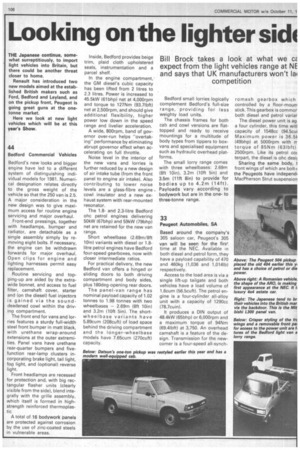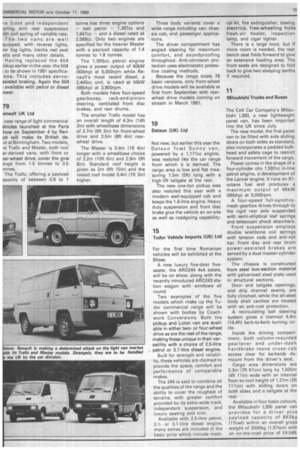Looking on the lighter side
Page 108

Page 109

If you've noticed an error in this article please click here to report it so we can fix it.
Bedford's new looks and bigger engine have led to a different system of distinguishing individual models for 1981. Numerical designation relates directly to the gross weight of the vehicle so that the 250 van is 2.5. A major consideration in the new design was to give maximum access for routine engine servicing and major overhaul.
Front-end pressings, together with headlamps, bumper and radiator, are detachable as a single assembly simply by removing eight bolts. If necessary, the engine can be withdrawn forwards for major overhaul. Open clips for engine and lighting harnesses permit easy replacement.
Routine servicing and topping-up are aided by the extrawide bonnet, and access to fuel filter, camshaft cover, starter and (on the diesel) fuel injectors is gained via the sounddeadened cowl within the driving compartment.
The front end for vans and lorries features a sturdy full-width steel front bumper in matt black, with urethane wrap-around extensions at the outer extremities. Panel vans have urethane rear-quarter bumpers and fivefunction rear-lamp clusters incorporating brake light, tail light, foci light, and (optional) reverse light.
Front headlamps are recessed for protection and, with big rectangular flasher units (clearly visible from the side), blend integrally with the grille assembly, which itself is formed in highstrength reinforced thermoplastic A total of. 16 bodywork panels are protected against corrosion by the use of zinc-coated steels in vulnerable areas. Inside, Bedford provides beige trim, plaid cloth upholstered seats, instrumentation and a parcel shelf.
In the engine compartment, the GM diesel's cubic capacity has been lifted from 2 litres to 2.3 litres. Power is increased to 45.5kW (61bhp) net at 4,000rpm and torque to 127Nm (93.7Ibft) net at 2,500rpm, and should give additional flexibility, higher power low down in the speed range and livelier acceleration.
A wide, 800rpm, band of governor over-run helps "overtaking" performance by eliminating abrupt governor effect when accelerating on full throttle.
Noise level in the interior of the new vans and lorries is further reduced by a new design of air intake tube (from the front panel to engine air intake). Also contributing to lower noise levels are a glass-fibre engine cowl insulator and a new exhaust system with rear-mounted resonator.
The 1.8and 2.3-litre Bedford ohc petrol engines delivering 50kW (67bhp) and 59kW (79bhp) net are retained for the new van range.
Short wheelbase (2.69m/8ft 10in) variants with diesel or 1.8litre petrol engines have Bedford four-speed gearboxes, now with closer intermediate ratios.
For practical delivery, the new Bedford van offers a hinged or sliding doors to both driving compartment. and body sides, plus 180deg-opening rear doors.
The panel-van range has nominal payload capacity of 1.02 tonnes to 1.98 tonnes with two wheelbases — 2.69m (8ft 10in) and 3.2m (10ft 5in). The shortwheelbase variants have 5.89cum (208cuft) of load space behind the driving compartment and the longer-wheelbase models have 7.65cum (270cuft) capacity. Bedford small lorries logically complement Bedford's full-size range, providing for less weighty load units.
The chassis frames for both cab and cowl versions are flattopped and ready to receive mountings for a multitude of body types from tippers to boxvans and specialised equipment such as hydraulic overhead platforms.
The small lorry range comes with three wheelbases: 2.69m (8ft 10in), 3.2m (10ft Sin) and 3.5m (lift 8in) to provide for bodies up to 4.2m (1 4ft). Payloads vary according to bodywork but are in the oneto three-tonne range.
Based around the company's 305 saloon car, Peugeot's 305 van will be seen for the firs'. time at the NEC. Available in both diesel and petrol form, they have a payload capability of 470 and 460kg (1,036 and 1,0141b) respectively.
Access to the load area is via a single lift-up tailgate and both vehicles have a load volume of 1.6cum (56.5cuft). The petrol engine is a four-cylinder all-alloy unit with a capacity of 1290cc (78.7cuin).
It produces a DIN output of 48.4kW (65bhp) or 6,000rpm and a maximum torque of 94Nm (69.4Ibft) at 3,750. An overhead camshaft is a feature of the design. Transmission for the newcomer is a four-speed all-synch romesh gearbox which controlled by a floor-mouni stick. This gearbox is commor both diesel and petrol variar The diesel power unit is ag. a four cylinder, this time witl capacity of 1548cc (94.5cui Maximum power is 36.51 (49bhp) at 5000rpm with rr torque of 85Nm (63Ibft) 2500rpm. Like its petrol cot terpart, the diesel l is ohc desk Sharing the sable body, 1 front wings of which are boltthe Peugeots have independi MacPherson Strut suspension
le front and independent .ailing arm rear suspension rith coil spring of variable rate. The two vans are well quipped, with reverse lights, tar fog lights, inertia reel seat elts and many other details. Having replaced the 404 ickup earlier in the year, the 504 ; to be shown in 1981 specificaons. This includes servossisted braking. Again the 504 ; available with petrol or diesel ower.
. new range of light commercial ehicles launched at the Paris how on September 4 by Penult will make its British deut at Birmingham. Two models,, le Trafic and Master, both non ar-derived vans, with front or aar-wheel drive, cover the gvw ange from 1.5 tonnes to 3.5 Dnnes.
The Trafic, offering a payload apacity of between 0.8 to 1 tonne has three engine options — two petrol — 1,397cc and 1,647cc — and a diesel rated at 2,068cc. Only two engines are specified for the heavier Master with a payload capacity of 1.4 tonnes to 1.8 tonnes.
The 1,995cc petrol engine gives a power output of 60kW (80bhp) at 5,000rpm while Renault's most recent diesel, a 2,445cc unit, is rated at 50kW (68bhp) at 3,900rpm.
Both models have four-speed gearboxes, rack-and-pinion steering, ventilated front disc brakes, and rear drums.
The smaller Trafic model has an overall length of 4.3m (14ft 3in) with wheelbase dimensions of 2.7m (9ft 2in) for front-wheel drive and 2.5m (8ft 4in) rearwheel drive.
The Master is 0.4m (1ft 4in) longer with a wheelbase choice of 3.2m (10ft Gin) and 2.9m (9ft Bin). Standard roof height is given as 2m (6ft 10in) and the raised roof model 0.4m (1ft 3in) higher. Three body variants cover a wide range including van, chassis cab, and passenger applications.
The driver compartment has angled steering for maximum comfort, and soundproofing throughout. Anti-corrosion protection uses electrostatic protective coating methods.
Because the range totals 78 basic versions, only front-wheel drive models will be available at first from September with rearwheel drive models coming on stream in March 1981.
Not new, but earlier this year the Datsun 7cwt Sunny van, powered by a 1,171cc engine, was restyled like the car range from which it is derived. The cargo area is low and flat measuring 1.5m (5ft) long with a high-lift tailgate at the rear.
The new one-ton pickup was also restyled this year with a modern well-equipped cab and keeps the 1.6-litre engine. Heavy duty suspension and front disc brake give the vehicle an on-site as well as roadgoing capability.
For the first time Romanian vehicles will be exhibited at the Show.
A new luxury five-door fiveseater, the AR0244 4x4 estate, will be on show, along with the recently introduced AR0243 station wagon with windows all round.
Two examples of the five models which make up the Tudor commercial range will be shown with bodies by Coachwork Conversions. Both the pickup and Luton van are available in either twoor four-wheel drive as are the rest of the range, making these unique in their versatility with a choice of 2.5-litre petrol or 3.1-litre diesel engine.
Built for strength and reliability, these vehicles are claimed to provide the space, comfort and performance of comparable makes.
The 244 is said to combine all the qualities of the range and the ability to cover the roughest of terrains, with greater comfort provided by its extra-wide track, independent suspension, and luxury seating and trim.
Available with 2.5-litre petrol, 2.1or 3.1-litre diesel engine, many extras are included in the basic price whic1,-).include medi7
cal kit, fire extinguisher, towing electrics, free-wheeling hubs fresh-air heater, inspection lamp, and cigar lighter.
There is a large boot, but if more room is needed, the rear bench seat folds forward to give an extensive loading area. The front seats are designed to fold back to give two sleeping berths if required.
The Colt Car Company's Mitsubishi L300, a new lightweight panel van, has been imported into the UK since July.
The new model, the first panel van to be fitted with side sliding doors on both sides as standard, also incorporates a padded bulkhead and safety cage to restrict forward movement of the cargo.
Power comes in the shape of a four-cylinder ohc 1,597cc in-line petrol engine, a development of the Lancer engine. It runs on 91octane fuel and produces a maximum output of 48kW (66bhp) at 5,000rpm.
A four-speed full-synchromesh gearbox drives through to the rigid rear axle suspended with semi-elliptical leaf springs and telescopic shock absorbers.
Front suspension employs double wishbone coil springs with tension rods and anti-roll bar. Front disc and rear drum power-assisted brakes are served by a dual master-cylinder system.
The chassis is constructed from. steel box-section material with galvanised steel plate used in structural sections.
Door and tailgate openings, and drip channel seams, are fully clinched, while the all-steel body shell cavities are treated with an anti-rust protection.
A recirculating ball steering system gives a claimed 4.4m (14.4ft) kerb-to-kerb turning circle.
Inside the driving compartment, both column-mounted gearlever and under-dash handbrake leave cross-cab access clear for kerbside demount from the driver's seat.
Cargo area dimensions are 2.3m (7ft 61/2in) long by 1.505m (4ft 11in) wide with an internal floor-to-roof height of 1.21m (3ft 111bin) with sliding doors on both sides and a tailgate at the rear.
Available in four basic colours, the Mitsubishi L300 panel van provides for a driver plus payload capacity of 863kg (17cwt) within an overall gross weight of 2000kg 11.97ton) with an on-the-road price of £4,549.












































































































































































